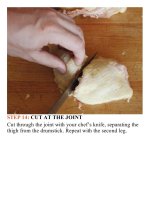The food lab better home cooking through science ( PDFDrive ) 58
Bạn đang xem bản rút gọn của tài liệu. Xem và tải ngay bản đầy đủ của tài liệu tại đây (177.65 KB, 2 trang )
don’t feel the need to make sure my bread knife fits my
handlikeaglove.Andsinceserratedbladesaredifficult,if
notimpossible,tosharpenathome,abreadknifewon’tlast
youaslongasyourchef’sknifewill.
You’ll find bread knives with pointed teeth, scalloped
teeth, and microserrations. I find that the best knives have
wide sharp teeth, a forged (not stamped) blade for better
sharpness and weight, and a good length. My first bread
knife was the Zwilling J. A. Henckels Twin Pro S 8-inch
BreadKnife(about$85),anditservedmewellforabouta
decade.MycurrentbreadknifeistheF.DickForged8-inch
Bread Knife (about $65). It works just as well as the
Henckels.Ifyou’reonatighterbudget,youcoulddoworse
thantheVictorinoxFibroxbreadknife(around$25).
4.A6-InchBoningKnife
Sure, you don’tthink you’re going to be doing a lot of
boninginyourkitchen....Wait,thatcameoutwrong.Let’s
start over: you may not be removing the bones from many
chickens or pig’s legs right now, but I hope I’ll be able to
convinceyouthatthosearebothgoodsskillstohaveunder
yourbelt.Itnotonlysavesyoumoney(lotsofit),butitalso
increasesthedeliciousnessyouareabletoproduceinyour
kitchen(we’llgettowhylateron).
A boning knife should be thin and moderately flexible,
withaverysharptip.Theideaisthatyouwanttobeableto
get that knife in between all the meat and the bones,
workingyourwayin,out,andaroundstructuresthataren’t
necessarily straight. A thin, flexible blade aids in this
process.A good boning knife should also be made with a
foot—an extra bit of metal jutting out of the heel—which
you can use to scrape meat and connective tissue off the
bonestocleanthem.I’veyettofindamorecapableboning
knifethantheWüsthofClassic6-inchFlexibleBoningKnife
(about$85).
5.AGoodHeavyCleaver
First things first: avoid expensive Japanese or German
cleavers, period. If they sell it at Williams-Sonoma, you
don’twantit.Acleaverismeanttobeforonlythetoughest
of the tough jobs, and it will get beat up. It doesn’t require
the razor-sharp edge-maintaining abilities of expensive
German or Japanese steel, so there’s no sense in paying a
higher price for one when cheaper models are just as
serviceable.
My favorite is a heavy-duty 2-pound, full-tang, 8-inchbladed behemoth of a cleaver that I got for $15 at a
restaurant supply store in Boston’s Chinatown. I use it
nearly daily for taking apart chickens, hacking through
animal bones, mincing beef or pork for hand-chopped
burgers or dumplings, cleaving hearty vegetables, and
tryingtolookreallybadassinthemirror(it’snotsogoodat
thatparticularfunction).Ifyouliveneararestaurantsupply
store, check it out for similar deals. As with all knives,
you’re looking for solid construction and a full tang. A
cleavershouldbeplentyheavyaswell.
Alternatively, you can get the more mass-market 7-inch
wood-handledcleaverfromDexter-Russell(about$40).It’s
a tad more expensive—you’re paying for the label—but it
does exactly what it’s supposed to do: hack the shit out of









